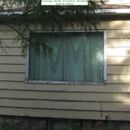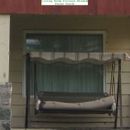图片窗口self-filled氩
Related GBA questions for this project:
//m.etiketa4.com/community/forum/gba-pro-help/93581/attic-insulation-quandary
//m.etiketa4.com/community/forum/gba-pro-help/101452/update-attic-insulation-quandary
Going to be addressing the exterior this season. I have some ideas on what to do with the 2 picture windows that will be kept. All other windows will be replaced.
There are 2 picture windows on the 1st floor. The glass areas are:
In dining room facing east, 5’ H x 7’ 8” W
In living room, facing south (shaded by a floor above), 5’H x 6’ 4” W
The inner glass is a IGU (Insulated Glazing Unit) made in? A 2nd single-pane was added in the 70s (guess) to the exterior of the IGU with a spacing of 2” or more (guess). During the summer, there is condensation present between the IGU and the added single-pane of the dining room window indicating trapped moisture. The south facing window is sheltered from rain and has not been as weathered as the east facing – don’t see condensation yet.
The outer storm pane needs to be removed, the wood repaired if needed, cleaned and painted. Both panes cleaned well and outer pane re-installed.
When adding external insulation over the original siding, the jambs, head and sill of these 2 picture windows will need to be extended so the new siding can abut the new jambs. The SPF will form a fillet on the outside of the added extension jambs surrounding the window, making a continuous air barrier around the extension jamb to the exterior insulation. Not sure if I’m using the correct terms; hope the idea comes across.
I’m considering adding air pathways (tubes) from inside the house (near the window trim) to the cavity between the 2 panes. One for supplying new air or inert gas and another to vent when replacing the trapped gas. Both would have a valve of some sorts to seal the chamber between the 2 panes and be inconspicuous. This way if moisture appears in the future, it could be flushed out with dry air or an inert gas such as Argon.
Found this info on why Argon is used in IGUs:
Argon is heavier than air and composes 2% of the atmosphere. Harmless if it leaks. “Argon, which has 34% lower thermal conductivity than air, is the most commonly used. Although argon-filled units cost around 5% more than air-filled units, they can improve a double glazing window’s U value or energy rating by over 30%”
Having the ‘valves’ at the top of the window seems to be preferable – can more easily hide from view. Argon is heavier than air; want the bottom well sealed.
If filled with Argon, the optimal spacing is 11mm to 19mm. ½ inch to ¾ inch.
//m.etiketa4.com/community/forum/green-products-and-materials/28218/optimal-argon-cavity-triple-pane-windows
Looking at:http://buyat.ppg.com/glasstechlib/75_TD121F.pdfandhttp://buyat.ppg.com/glasstechlib/7_TD101F.pdf
7/16 is optimum for center-of-glass U value. The U of 0.3 for just air improves to 0.25 for Argon.
Seems like a worthy goal. I’ve got friends in the area that have Argon for their welding equipment. Just need a mechanism to insert it between the panes.
OPTION: should the east-facing outer pane have the inner surface of the window coated to reduce the SHGC. I believe the general answer for zone 7 is NO due to losing the solar gain during the winter. BUT, this is an east facing window and doesn’t get much light during the winter months but may get a lot of sunlight during the summer (depending on size and proximity of surrounding trees) – increasing cooling costs. It is a big window.
OPTION: should we consider adding a 3rd outer pane?
GBA Detail Library
A collection of one thousand construction details organized by climate and house part












Replies
Tim,
I think this is a fool's errand. Experiment if you want, but it's not a good use of your time or resources.
1. When you try to introduce argon between the panes, you will end up with a mix of argon and atmospheric gases -- not pure argon. You'll also have some water vapor.
2. You will be unable to make this space tight enough to prevent the argon from escaping.
3. The usual way to reduce the chance of condensation is to create an excellent air seal around the primary (interior) window, but to install the exterior storm without much attention to air sealing. You want a little bit of air movement around the exterior storm. That should eliminate your condensation problem.
4. Or you can always buy a triple-glazed IGU or a triple-glazed fixed window if you want.
-- Martin Holladay
I think you should replace your siding.